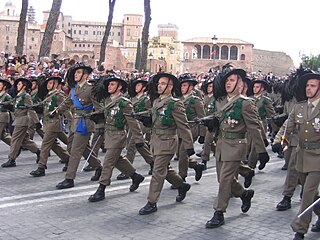
The Bersaglieri, singular Bersagliere, are a troop of marksmen in the Italian Army's infantry corps. They were originally created by General Alessandro Ferrero La Marmora on 18 June 1836 to serve in the Royal Sardinian Army, which later became the Royal Italian Army. They can be recognized by their distinctive wide-brimmed hats decorated with black western capercaillie feathers, which is worn with the dress uniform. The feathers are also applied to their combat helmets.

The 132nd Armored Division "Ariete" was an armored division of the Royal Italian Army during World War II. It was formed in 1939 as the second armored division after the 131st Armored Division "Centauro". The division fought in the Western Desert Campaign until being destroyed during the Second Battle of El Alamein and declared lost due to wartime events on 8 December 1942.
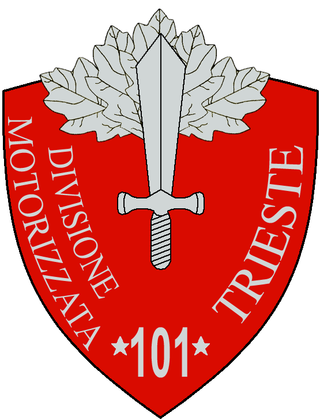
101st Motorized Division "Trieste" was a motorized infantry division of the Royal Italian Army during World War II. The Trieste was formed in 1939 and named for the city of Trieste. The division and its infantry and artillery regiments were based in Piacenza, while the 9th Bersaglieri Regiment was based until 1940 in Treviso and then moved to Cremona to be closer to the division. In September 1941 the Trieste was transferred to Libya for the Western Desert Campaign. The division was decimated in the Second Battle of El Alamein, but was rebuilt with the survivors of destroyed divisions. The Trieste then participated in the Tunisian Campaign until Axis forces in Tunisia surrendered to allied forces on 13 May 1943.
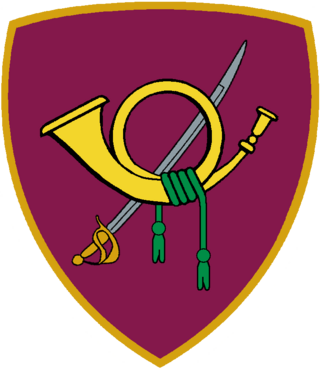
The Bersaglieri Brigade "Garibaldi" is a mechanized infantry brigade of the Italian Army, based in the south of the country. Its core units are Bersaglieri, an elite infantry corps of the Italian Army. The brigade is named after Giuseppe Garibaldi, a hero of the Italian wars of unification. The brigade is part of the Division "Acqui".
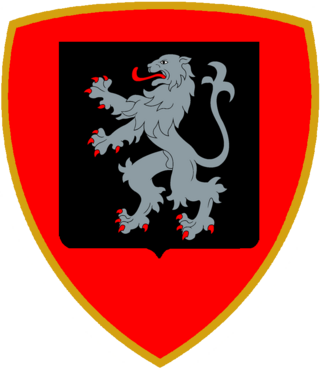
The Mechanized Brigade "Aosta" is a mechanized infantry brigade of the Italian Army based on the island of Sicily. The Brigade is one of the oldest of the Italian Army and the name connects the brigade to its original area of recruitment the Aosta Valley and therefore the brigade's coat of arms is modeled after the coat of arms of Aosta. The brigade is part of the Division "Acqui".

The 131st Armored Division "Centauro" was an armored division of the Italian Army during World War II. The division was formed in April 1939 by expanding the I Armored Brigade. The division's name came from the mythological race of half human-half horse creatures named Centaurs. The division participated in the invasion of Albania, Greco-Italian War, and invasion of Yugoslavia. In August 1942 the division was sent to Libya to participate in the Western Desert Campaign. After the Axis defeat at the Second Battle of El Alamein the division retreated with the German-Italian Panzer Army to Tunisia, where the division participated in the Tunisian Campaign. On 18 April 1943 the division was disbanded due to the losses suffered in the Battle of El Guettar.

133rd Armored Division "Littorio" was an armored division of the Royal Italian Army during World War II. The division's name derives from the fasces carried by the lictors of ancient Rome, which Benito Mussolini had adopted as symbol of state-power of the fascist regime. Sent to North Africa in January 1942 for the Western Desert Campaign the division was destroyed in the Second battle of El Alamein in November 1942.

80th Infantry Division "La Spezia" was an infantry division of the Royal Italian Army during World War II. The La Spezia was formed on 15 November 1941 and named for the city of La Spezia. The La Spezia division was the only air-transportable division of the army and earmarked for the planned invasion of Malta. In November 1942 the division was sent to Libya to participate in the North African Campaign. On 13 May 1943 the La Spezia surrendered to Allied forces in Tunisia.

The 1st Infantry Division "Superga" was an infantry division of the Royal Italian Army during World War II. The Superga was classified as a mountain infantry division, which meant that the division's artillery was moved by pack mules instead of the horse-drawn carriages of line infantry divisions. Italy's real mountain warfare divisions were the six alpine divisions manned by Alpini mountain troops. The Superga recruited primarily from central Piedmont and was based, together with its two infantry regiments, in Turin, while the 5th Artillery Regiment was based in Venaria Reale. The division was and named for the Superga hill near Turin, where members of Italy's Royal House of Savoy were buried in the Basilica of Superga.
The 207th Coastal Division was an infantry division of the Royal Italian Army during World War II. Royal Italian Army coastal divisions were second line divisions formed with reservists and equipped with second rate materiel. Recruited locally, they were often commanded by officers called out of retirement.

The 2nd Cavalry Division "Emanuele Filiberto Testa di Ferro" was a Cavalry or "Celere" (Fast) division of the Royal Italian Army during World War II. The division was mobilised in 1940, it did not take part in the Italian invasion of France, but did serve in the Invasion of Yugoslavia and remained in Yugoslavia as part of the occupying forces. In March 1942 the division's 6th Bersaglieri Regiment was sent to the Soviet Union attached to the 3rd Cavalry Division "Principe Amedeo Duca d'Aosta". In May 1942 the division started converting to an armored division, however, the conversion was cancelled and it returned to the Cavalry format. In December 1942, the division moved to France as part of the Italian occupying forces where it was based in Toulon. The division remained in France until the Armistice of Cassibile was announced on 8 September 1943 and was then disbanded by the invading Germans.
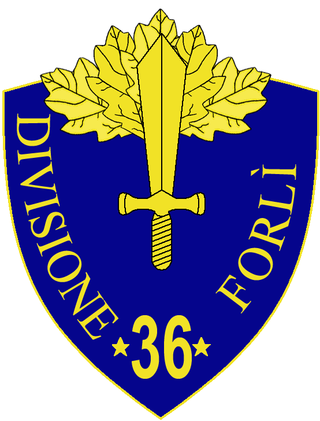
The 36th Infantry Division "Forlì" was a infantry division of the Royal Italian Army during World War II. The Forlì was classified as a mountain infantry division, which meant that the division's artillery was moved by pack mules instead of the horse-drawn carriages of line infantry divisions. Italy's real mountain warfare divisions were the six alpine divisions manned by Alpini mountain troops. The division was formed on 31 March 1939 and named for the city of Forlì. The division was based in Saluzzo and most of its troops were drafted in the surrounding Langhe region in southern Piedmont. The division's two infantry regiments were based in Alba (43rd) and Saluzzo (44th), with the division's artillery regiment also based in Saluzzo.
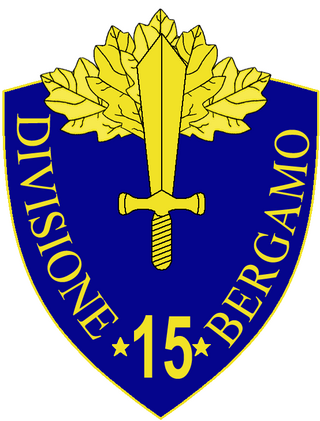
The 15th Infantry Division "Bergamo" was an infantry division of the Royal Italian Army during World War II. The Bergamo was based in Istria and named for the city of Bergamo.

The 44th Infantry Division "Cremona" was an infantry division of the Royal Italian Army during World War II. The Cremona was formed on 15 September 1939 by splitting the 20th Infantry Division "Curtatone and Montanara" into the 20th Infantry Division "Friuli" and 44th Infantry Division "Cremona". The division was named for the city of Cremona. The division served as occupation force on Corsica and fought German units after the Armistice of Cassibile was announced on 8 September 1943. The division then served with the Italian Co-belligerent Army and remained active until the 1975 Italian Army reform.
The 136th Armored Division "Giovani Fascisti" was an infantry division of the Royal Italian Army during World War II.

The 158th Infantry Division "Zara" was an infantry division of the Royal Italian Army during World War II. The Zara was formed on 1 September 1942 and named for the city of Zadar. The Zara was classified as an occupation infantry division. The division remained on the Dalmatian coast until it was disbanded on 9 September 1943 in the wake of the announcement of the Armistice of Cassibile.
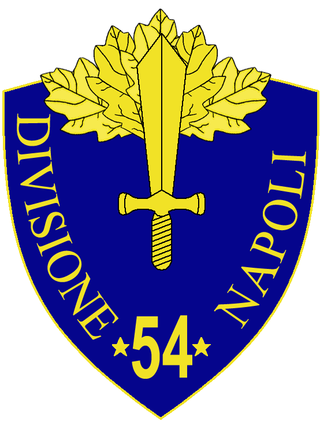
The 54th Infantry Division "Napoli" was an infantry division of the Royal Italian Army during World War II. The Napoli was formed on 15 April 1939 in Caltanissetta and named for the city of Naples. The division dissolved on 14 August 1943 in Melia southeast of Scilla in Calabria after being heavily decimated during the Allied invasion of Sicily. The division drafted men in southern Sicily and members of the division hailed from Caltanissetta, Agrigento, Syracuse and the surrounding territories.

After World War II the Italian Army had two units named "Centauro": from 1952 to 1986 the Armored Division "Centauro" and from 1986 to 2002 the Armored Brigade "Centauro". Both units were successor to the World War II era 131st Armored Division "Centauro". The units' name came from the mythological race of half human-half horse creatures named Centaurs.

The Mechanized Brigade "Legnano" was a mechanized brigade of the Italian Army. Its core units were mechanized infantry battalions. The brigade's headquarters was in the city of Bergamo in Lombardy. The name of the brigade commemorates the Lombard League victory in the Battle of Legnano in 1176 and its coat of arms depicts the Monument to the Warrior of Legnano in the centre of Legnano.

The 91st Infantry Regiment "Basilicata" is an inactive unit of the Italian Army last based in Potenza. The regiment is named for the region of Basilicata and part of the Italian Army's infantry arm.

















